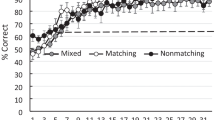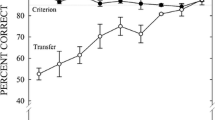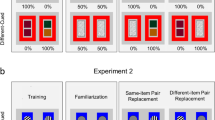Abstract
Pigeons were initially trained to match each of two sample stimuli to two different comparison stimuli (one-to-many matching). Afterwards, they learned to match one comparison from each associative set to new samples. Then, in a test phase, the remaining comparisons were substituted for those used in the interim phase. Two birds showed evidence of transfer during testing but the majority matched at accuracy levels close to chance. This relatively weak transfer effect contrasts with more robust transfer obtained after other training regimens (Urcuioli, Zentall, Jackson-Smith, & Steirn, 1989), suggesting a possible “direction-of-training” effect in producing emergent stimulus relations in pigeons’ matching-to-sample.
Similar content being viewed by others
References
DUBE, W. V., MCILVANE, W. J., MAGUIRE, R. W., MACKAY, H. A., & STODDARD, L. T. (1989). Stimulus class formation and stimulus-reinforcer relations. Journal of the Experimental Analysis of Behavior, 51, 65–76.
FIELDS, L., & VERHAVE, T. (1987). The structure of equivalence classes. Journal of Experimental Analysis of Behavior, 48, 317–322.
FIELDS, L., VERHAVE, T., & FATH, S. (1984). Stimulus equivalence and transitive associations: A methodological analysis. Journal of the Experimental Analysis of Behavior, 42, 143–157.
GRANT, D. S. (1982). Prospective versus retrospective coding of samples of stimuli, responses, and reinforcers in delayed matching with pigeons. Learning & Motivation, 13, 265–280.
HAYES, S. C. (1989). Nonhumans have not yet shown stimulus equivalence. Journal of the Experimental Analysis of Behavior, 51, 385–392.
HOGAN, D. E., & ZENTALL, T. R. (1977). Backward associations in the pigeon. American Journal of Psychology, 90, 3–15.
LAZAR, R. M., DAVIS-LANG, D., & SANCHEZ, L. (1984). The formation of stimulus equivalences in children. Journal of the Experimental Analysis of Behavior, 41, 251–266.
SANTI, A., & ROBERTS, W. A. (1985). Prospective representation: The effects of varied mapping of sample stimuli to comparison stimuli and differential trial outcomes on pigeons working memory’. Animal Learning & Behavior, 13, 103–108.
SAUNDERS, K. J. (1989). Naming in conditional discrimination and stimulus equivalence. Journal of the Experimental Analysis of Behavior, 51, 379–384.
SAUNDERS, R. R., WÄCHTER, J., & SPRADLIN, J. E. (1988). Establishing auditory stimulus control over an eight-member equivalence class via conditional discrimination procedures. Journal of the Experimental Analysis of Behavior, 49, 95–115.
SIDMAN, M. (1990). Equivalence relations: Where do they come from? In H. Lejeune & D. Blackman (Eds.), Behaviour analysis in theory and practice: Contributions and controversies (pp. 93–114). Hillsdale, NJ: Erlbaum.
SIDMAN, M., & TAILBY, W. (1982). Conditional discrimination vs. matching-to-sample: An expansion of the testing paradigm. Journal of the Experimental Analysis of Behavior, 37, 5–22.
SPRADLIN, J. E., COTTER, V. W., & BAXLEY, N. (1973). Establishing a conditional discrimination without direct training: A study of transfer with retarded adolescents. American Journal of Mental Deficiency, 77, 556–566.
SPRADLIN, J. E., & SAUNDERS, R. R. (1986). The development of stimulus classes using match-to-sample procedures: Sample classification versus comparison classification. Analysis & Intervention in Developmental Disabilities, 6, 41–58.
URCUIOLI, P. J., ZENTALL, T. R., JACKSON-SMITH, P., STEIRN, J. N. (1989). Evidence for common coding in many-to-one matching: Retention, intertrial interference, and transfer. Journal of Experimental Psychology: Animal Behavior Processes, 15, 264–273.
VAUGHAN, W., Jr.. (1989). Reply to Hayes. Journal of the Experimental Analysis of Behavior, 51, 397.
WASSERMAN, E. A., DEVOLDER, C. L., & COPPAGE, D. J. (1992). Nonsimilarity-based conceptualization in pigeons via secondary or mediated generalization. Psychological Science, 6, 374–379.
WETHERBY, B., KARLAN, G. R., & SPRADLIN, J. E. (1983). The development of derived stimulus relations through training in arbritrary-matching sequences. Journal of the Experimental Analysis of Behavior, 40, 69–78.
ZENTALL, T. R., SHERBURNE, L. M., & STEIRN, J. N. (1992). Development of excitatory backward associations during the establishment of forward associations in a delayed conditional discrimination by pigeons. Animal Learning & Behavior, 20, 199–206.
ZENTALL, T. R., SHERBURNE, L. M., STEIRN, J. N., RANDALL, C. K., ROPER, K. L., & URCUIOLI, P. J. (1992). Common coding in pigeons: Partial versus total reversals of one-to-many conditional discriminations. Animal Learning & Behavior; 20, 373–381.
ZENTALL, T. R., STEIRN, J. N., SHERBURNE, L. M., & URCUIOLI, P. J. (1991). Common coding in pigeons assessed through partial versus total reversals of many-to-one conditional and simple discriminations. Journal of Experimental Psychology: Animal Behavior Processes, 17, 194–201.
Author information
Authors and Affiliations
Additional information
This research was supported by NSF Grant BNS-9009666 to Peter Urcuioli. We gratefully acknowledge JeAndra Barner and Tom DeMarse for running the subjects, and Lanny Fields for comments on an earlier draft. Portions of these data and related findings were presented at the 15th Annual Harvard Symposium on the Quantitative Analyses of Behavior.
Rights and permissions
About this article
Cite this article
Urcuioli, P.J., Zentall, T.R. A Test of Comparison-Stimulus Substitutability Following One-to-Many Matching by Pigeons. Psychol Rec 43, 745–759 (1993). https://doi.org/10.1007/BF03395910
Published:
Issue Date:
DOI: https://doi.org/10.1007/BF03395910




